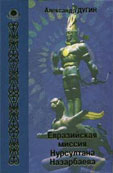 |
|
|||||
|
|
||||||
|
||||||||||||
|
Aleksandr DuginMAIN PRINCIPLES OF EURASIST POLICY1. Three patterns (Soviet, pro-Western, Eurasist)
The first pattern represents the inertial cliché of the Soviet (mainly later Soviet) period. It has somehow taken roots in the psychology of some Russian managing systems, often unconsciously, pushing them into adopting such or such decision on the basis of the precedents. This pattern is supported with the “relevant” argument: «It worked earlier, it will work also now». It concerns not only those political leaders who consciously exploit the nostalgic complex of the Russian citizens. The Soviet reference pattern is much wider and deeper than the structures of the KPFR [Communist Party of the Russian Federation], which now stands at the rim of executive power, far from the decisional centres. Everywhere politicians and officials, formally not identifying themselves in any way with communism, are guided by it. It is an effect of education, life experience, formation. In order to understand the substance of the undergoing processes in Russian politics, it is necessary to admit this “unconscious sovietism”. The second pattern is the liberal-democrat, pro-American one. It started taking shape with the beginning of “perestroyka” and became some kind of dominant ideology in the first half of the 1990s. As a rule, the so-called liberal-reformers and the political forces close to them identify themselves with it. This pattern is based on choosing as system of reading of the American socio-political device, copying it on the Russian ground and following US national interests in international issues. Such pattern has the advantage to allow to lean on the quite real “foreign present”, as against the virtual “domestic past” around which the first pattern gravitates. The argument here too is rather simple: «It works for them, it will work for us too». Here it is important to stress that we are not simply talking about “foreign experience”, but about the orientation towards the US, as to the flagship of the successful Western capitalist world. These two patterns (plus their manifold variations) are diffusely represented in Russian politics. Since the end of the 1980s all basic world-view conflicts, discussions and political fights takes place between the bearers of these two views. The third pattern is much less known. It can be defined as “eurasist”. We are dealing here with much more complex operations, than simply copying the Soviet or American experience. This pattern refers both to the domestic past and to the foreign present in terms of differentiation: it derives something from our political history, something from the reality of modern societies. The eurasist pattern recognises that Russia (as a State, as a people, as a culture) is an autonomous civilisation value, that she should save its uniqueness, independence and power in that that became, having put at the service of this purpose any doctrine, system, mechanism and political technique which can to this encourage. Eurasism, in this way, is an original “patriotic pragmatism”, free from any dogmatics - be it Soviet or liberal. But at the same time, the wideness and flexibility of the eurasist approach do not prevent this theory from being conceptually systematic, possessing all the marks of an organic, consequent, internally consistent world-view. As the two former orthodox patterns show their unfitness, eurasism becomes more and more popular. The Soviet pattern operates with obsolete political, economic and social realities, it exploits nostalgia and inertness, it lacks a sober analysis of the new international situation and the real development of world economic trends. The pro-American liberal pattern, in turn, can not be realised in Russia by definition, being an organic part of another civilisation, alien to Russia. This is well understood in the West too, where nobody disguises their preference to see not a prospering and safe Russia, but, on the contrary, a weakened Russia, submerged in the abyss of chaos and corruption. Therefore today the eurasist pattern becomes most urgent, most demanded by the society. So we must take a closer look at
it. 2. Eurasism and Russian foreign policy
We shall start from foreign policies. As in every political field, also in foreign policy eurasism proposes to follow the third path - neither sovietism, nor americanism. It means that Russian foreign policies should not directly reconstruct the diplomatic profile of the Soviet period (rigid opposition to the West, recovering a strategic partnership with “rogue countries” - North Korea, Iraq, Cuba etc.) while at the same time it must not blindly follow the American advisors. Eurasism offers its own foreign policy doctrine. Its essence can be summarised as follows. Contemporary Russia can be saved as an autonomous and independent political reality, as a valuable subject of international policy, only in the conditions of a multipolar world. Consenting to the unipolar American-centred world is impossible for Russia, since in such world she could be but one of the objects of globalisation, inevitably losing her independence and originality. The opposition to unipolar globalisation, the assertion of the multipolar pattern is the major imperative of contemporary Russian foreign policies. This condition must not be put into doubt by any political forces: and from this follows that the propagandists of American-centred globalisation inside Russia must be (at least morally) delegitimized. The construction of the multipolar world (vital for Russia) is feasible only through a system of strategic alliances. Russia alone cannot cope with this problem, not disposing of sufficient resources for complete autarchy. Therefore her success in many respects depends on the adequacy and activity of her foreign policy. In the modern world there are some geopolitical subjects which, due historical and civilisation reasons, also are vitally interested in multipolarity. In the situation now taking shape these subjects represent Russia's natural partners. They are divided in some categories. The first category: powerful regional formations (countries or group of countries), whose relations with Russia can be conveniently expressed by the term “complementary”. It means that these countries own something vital for Russia, while Russia owns something extremely indispensable for them. As a result, such strategic exchange of potentials strengthens both geopolitical subjects. To this category (symmetrically complementary) belong the European Union, Japan, Iran, India. All these geopolitical realities can quite reasonably claim to a role of autonomous subjects in conditions of multipolarity, while American-centrism deprives them of this possibility, reducing them to mere objects. As the new Russia cannot be presented as an ideological enemy (that which ensured the US their major argument for drawing Europe and Japan into their orbit, and confounded the USSR into being pulled together with Islamic Iran in the “cold war” period), the imperative of complete subordination of these countries to American geopolitics is practically no more substantiated with anything (except for historical inertia). Hence, the contradictions between the US and the powers reciprocally complementary to Russia will be continuously aggravated. If Russia will prove to be active and will substantiate with her potential the multipolar trend, finding for each of these geopolitical formations the right arguments and differentiated conditions for strategic alliance, the club of the supporters of multipolarity can become mighty and influential enough to efficiently achieve the realisation of its own project of future world system. To each of these powers Russia has what to offer - resources, strategic potential of weapons, political weight. In exchange Russia will receive, on the one hand, economic and technological sponsorship on behalf of the European Union and Japan, on the other hand - political-strategic partnership in the South on behalf of Iran and India. Eurasism conceptualises such foreign-policy course and substantiates it by the scientific methodology of geopolitics. The second category: geopolitical formations being interested in multipolarity, but not being symmetrically complementary to Russia. These are China, Pakistan, the Arab countries. The traditional policies of these geopolitical subjects have an intermediate character, but strategic partnership with Russia is not their major priority. Moreover, the eurasist alliance of Russia with the countries of the first category strengthens the traditional rivals of the countries of the second category at the regional level. For example, Pakistan, Saudi Arabia and Egypt have serious contradictions with Iran, as China with Japan and India. On a broader scale, the relations of Russia with China represent a special case, complicated by demographic problems, by the heightened interest of China to the scarcely populated territories of Siberia, and also the by absence at China of a serious technological and financial potential able to positively solve the major problem for Russia of technological assimilation of Siberia. All the countries of the second category are delivered before necessity to manoeuvre between America-centred unipolarity (which does not promise anything good for them) and eurasism. With regard to the countries of this category Russia must act with the utmost caution - not including them in the eurasist project, but at the same time aiming at neutralising as much as possible the negative potential of their reaction and actively countering their active inclusion in the process of unipolar globalisation (for which there are enough reasons). The third category represents the countries of the Third World which do not possess enough geopolitical potential to claim even to the status of limited subjects. Concerning these countries Russia should follow differentiated policies, contributing to their geopolitical integration in zones of “common prosperity”, under the control of the mighty partners of Russia within the Eurasian bloc. This means that in the Pacific zone it is convenient for Russia to favour the strengthening of the Japanese presence. In Asia it is necessary to encourage the geopolitical ambitions of India and Iran. It is also necessary to contribute to expanding the European Union influence in the Arab world and Africa as a whole. The same states which are included into a traditional orbit of Russian influence must naturally remain there or be brought back into it. To this effect the policy of integration of the countries of the CIS [Commonwealth of Independent States] to the Eurasian Union is directed. The fourth category: the US and
the countries of the American continent laying under US
control. The international eurasist policies of Russia
must be oriented to show by any means the US the
inconsistency of the unipolar world, the conflicting
character and irresponsibility of all process of
American-centred globalisation. Rigidly and actively
(using to this purpose, first of all, the instrument of
the Eurasian alliance) opposing such globalisation,
Russia should on the contrary support the isolationist
tendency in the US, saluting with favour the limitation
of US geopolitical interests to the American continent.
The US, as the strongest regional power, whose circle of
strategic interest is disposed between the Atlantic and
the Pacific Ocean, can even be a strategic partner
for an eurasist Russia. Moreover, such America will be
extremely desirable for Russia, as she will limit
Europe, the Pacific region, and also the Islamic world
and China, in case their aspiration were to follow a
path of unipolar globalisation on the basis of their own
geopolitical system. And if unipolar globalisation will
keep being staged, it is Russia's interest to back the
anti-American mood in Southern and Central America,
using, however, a much more flexible and wider
world-view and geopolitical device than Marxism. In the
same channel lays the policy of priority work with
anti-American political circles in Canada and Mexico.
Possibly also using in this direction the lobbyist
activity of the Eurasian diasporas in the US. 3. Eurasism and domestic policy
The integration of CIS countries into a united Eurasian Union is the major strategic imperative of eurasism. The minimal strategic volume indispensable for starting a serious international activity to the creation of a multipolar world is not the Russian Federation, but the CIS taken as a single strategic reality, fastened by a single will and a common civilisation purpose. The political system of the Eurasian Union in the most logical way is founded on the “democracy of participation” (the “demotia” of the classical eurasists), the accent being not on the quantitative, but on the qualitative aspect of representation. The representative authority should mirror the qualitative structure of the Eurasian society, instead of the average quantitative statistical indicators based on the efficiency of pre-election shows. Special attention should be given to the representation of ethnoses and religious confessions. The “democracy of participation” must be organically integrated with a definite fraction of individual responsibility as much as possible expressed in strategic areas. The Supreme Leader of the Eurasian Union must concentrate the common will to the achievement of power and prosperity of the state. The principle of the social imperative should be combined with the principle of personal freedom in a proportion essentially differing as much from liberal-democratic recipes, as from the impersonal collectivism of the Marxists. Eurasism supposes here the preservation of a definite balance, with a significant role of the public factor. In general, the active development of the social principle is a constant feature of the Eurasian history. It is shown in our psychology, ethics, religion. But as against the Marxist patterns the social principle should be affirmed as something qualitative, differentiated, linked with the concrete national, psychological, cultural and religious setting. The social principle must not suffocate, but strengthen the private principle, giving it a qualitative background. The qualitative understanding of the social factor allows precisely to define the golden mean between the hyper-individualism of bourgeois West and the hyper-collectivism of socialist East. In the administrative system eurasism insists on the model of “eurasist federalism”. This supposes choosing as the basic category for building the Federation not the territories, but the ethnoses. Having separated the principle of ethno-cultural autonomy from the territorial principle, eurasist federalism will forever liquidate the same reasons for separatism. So as a compensation the peoples of the Eurasian Union receive the possibility of maximal development of ethnic, religious and even, in some definite issues, juridical independence. The undoubted strategic unity in eurasist federalism is accompanied by ethnic plurality, by the emphasis on the juridical element of the “rights of the peoples”. The strategic control of the space of the Eurasian Union is ensured by the unity of management and federal strategic districts, in whose composition various formations can enter - from ethno-cultural to territorial. The immediate differentiation of territories into several levels will add flexibility, adaptability and plurality to the system of administrative management in combination with rigid centralism in the strategic sphere. The Eurasian society should be founded on the principle of a revived moral possessing both common features and concrete forms linked to the specificity of the ethno-confessional context. The principles of naturalness, purity, restraint, respect for the rules, liability, healthy life, righteousness and truthfulness are common to all traditional faiths of Eurasia. These undeniable moral values must be given the status of state norms. Scandalous social vices, impudent and public violation of moral foundations should be ruthlessly rooted out. The armed forces of Eurasia and the power ministries and offices must be considered as the strategic skeleton of the civilisation. The social role of the militaries should increase, it is necessary to restore their prestige and public respect. On the demographic plan is indispensable to achieve the “proliferation of the Eurasian population”, morally, materially and psychologically encouraging having many children, making of it the Eurasian social standard. In the field of education it is necessary to strengthen the moral and scientific education of youth in the spirit of faithfulness to historical roots, loyalty to the eurasist idea, liability, virility, creative activity. The activity of the informational sector of the eurasist society must be based on the strict observance of civilisation priorities in making light upon domestic and foreign events. The principles of formation and intellectual and moral education should be set above the principles of entertainment or commercial benefit. The principle of freedom of speech must be combined with the imperative of liability for the freely spoken words. Eurasism supposes the
creation of a society of a mobilisation kind, where the
principles of creation and social optimism should be the
standard of human life. The world-view should uncover
the potential possibilities of the man, enabling
everyone - overcoming (internal and external) inertia
and limitation - to express his unique personality in
the service of society. At the basis of the eurasist
approach to the social question lays the principle of a
balance between state and private. This balance is
defined by the following logic: all scale, related to
strategic sphere (military-industrial complex,
education, safety, peace, moral and physical health of a
nation, demography, economic growth etc.) is controlled
by the State. Small and medium production, the sphere of
services, personal privacy, the entertainment industry,
the sphere of leisure etc. are controlled not by the
State but on the contrary by personal and private
initiative (except for those cases when the latter
conflicts with the strategic imperatives of eurasism in
the global sphere). 4. Eurasism and the economy
The eurasist approach to the economy can be expressed as a simplified scheme in this way: state regulation of the strategic branches (military-industrial complex, natural monopolies and similar) and maximal economic freedom for medium and small business. The major element of the eurasist approach to the economy is the idea of the decision of a significant number of Russian national-economic problems within the framework of the eurasist foreign policy project. Is present in view of what. Some geopolitical subjects vitally interested in the multipolarity of the world - first of all, the European Union and Japan - have a huge financial-technological potential, whose engaging can sharply change the Russian economic climate. At the present stage it is regretfully necessary to acknowledge that there are no sufficient resources in Russia for (even relative) autarchy. Therefore investments and other kinds of interaction with the advanced economic regions is vitally necessary to us. This interaction should be initially plotted on the logician by more volumetric, rather than is narrow economic relations - investment, credits, import-export, energy deliveries etc. All this should be set in the wider context of common strategic programs - such as the joint assimilation of fields or the creation of unified Eurasian transport and information systems. In some sense Russia must lay the burden of the revival of its economic potential to the partners of the “club of supporters of multipolarity”, actively using to this purpose the possibility to offer extremely convenient joint transport projects (the “Trans-Eurasian main”) or vital energy resources for Europe and Japan . A relevant problem is also the return of capital to Russia. Eurasism creates very serious reasons to this purpose. The confused Russia of the period of liberal reforms (beginning in the 1990s), completely turned to the West, referring to herself with distaste, immersed in the psychosis of privatisation and corruption, and the eurasist, patriotic, state-oriented Russia of the beginning of the XXI century are diametrically opposite political realities. Capital fled a weak and collapsing Russia. In a Russia set on a path of strength and recovery, capital must return. In the Western countries most of the capitals taken out from Russia can neither be saved nor increased. In the beginning of the 1990s, the West looked with approval at Russian capital flight (mainly of criminal origin), considering – according to the “cold war” logic – that the weakening of post-communist Russia would play in the hands of NATO countries. Now the situation has sharply changed, and in the present conditions serious problems will arise (they already have, indeed) for the owners of illegal capitals in the West The eurasist logic means the
creation of the most favourable conditions to the return
of these capitals to Russia, which in itself will
provide a serious impulse to the development of the
economy. Contrary to some purely liberal abstract
dogmas, capital moves back faster to a state with
strong, accountable authority and precise strategic
orienting points, rather than to an uncontrollable,
chaotic and unstable country. 5. Eurasian path
Some definite aspects of eurasism are already being used by the new Russian authorities oriented to a creative solution of the difficult historical problems Russia has to face the in new century. And every time this happens, efficiency, effectiveness, serious strategic results speak for themselves. The integration processes in the CIS, the creation of the Eurasian Economic Commonwealth, the first steps of the new foreign policy of the Russian Federation concerning Europe, Japan, Iran and the countries of the Near East, the creation of a system of Federal districts, the strengthening of the vertical line of power, the weakening of the oligarchic clans, the policy of patriotism and statehood, the increase of responsibility in the work of the mass media – all these are relevant and essential elements of eurasism. For the time being these elements are intermingled by the inertial trends of the other two patterns (liberal-democrat and soviet). And yet it is perfectly clear that eurasism is steadily moving to its zenith, whereas two other patterns conduct only “rear-guard fight”. Enhancing the role of eurasism in
Russian politics is an evolutionary and gradual process.
But the time has already come for a more attentive and
accountable learning of this really universal theory and
philosophy, whose transformation into political and
world-view practice is under our eyes. Aleksandr Dugin, ph.d. June 2001 Trans. by
M.Conserva
|
Виды цветного металлопроката Воздушные завесы Топас 5 |
||||||||||||||||||||||||||||||||||||||||||||||||||||||


































